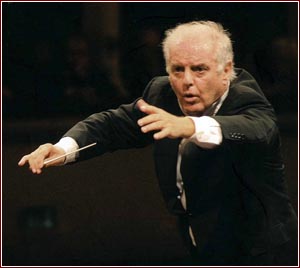 Daniel Barenboim interviewed by Clemency Burton-Hill, over at Eurozine:
Daniel Barenboim interviewed by Clemency Burton-Hill, over at Eurozine:
Clemency Burton-Hill: One of my strongest memories of rehearsing with you and the West-Eastern Divan is a moment when you reminded the members of the orchestra that every single one of their governments would stop them from being there if they could, and that what they were doing was therefore very brave. For all the adulation and acclaim that the Divan garners around the world, it strikes me that it is, essentially, a censored orchestra.
Daniel Barenboim: Yes, you're probably right. The Divan is not acceptable to any of the countries represented by its members. We can't play in any Arab countries except the Emirates, nor in Israel. The Israelis don't understand why it is even necessary to make the gesture. And the Arab world mostly sees the Divan as a way of normalisation, in the sense of accepting Israel, and all the problems that involves.
C. B.-H.: So the fact that those kids come together to make music with each other every year, in the face of governments who would silence them and despite recriminations from their friends and family at home, feels like something of a defiant act.
D. B.: It is. And you know, I believe more and more that it is up to individuals – or minorities – to express things which are not acceptable to the majority. Because there is always a special angle that an individual or a minority can have. And maybe the majority will eventually follow, but you cannot start a new idea that is going to change things with the blessing of the majority.
C. B.-H.: How important is it that the orchestra be allowed to make music freely in the Middle East?
D. B.: I think the full dimensions of the Divan will only be achieved when we are able to play in Tel Aviv, Damascus, Beirut, Cairo, because that is really what it is all about. On the other hand, if the conflict was resolved there would hardly be a need for the Divan. And so it is a bit of a contradiction in terms. The Divan came into existence and continues to develop because of the conflict, and it has not yet been fully able to push through its idea of accepting the narrative of the other, the point of view of the other. For that you need a yearning voice for justice and for compassion, from both sides. And the Israelis as a majority I don't think have a compassion for the rights of the Palestinians, otherwise they wouldn't be occupying the territories for so many years and they wouldn't blockade Gaza.
